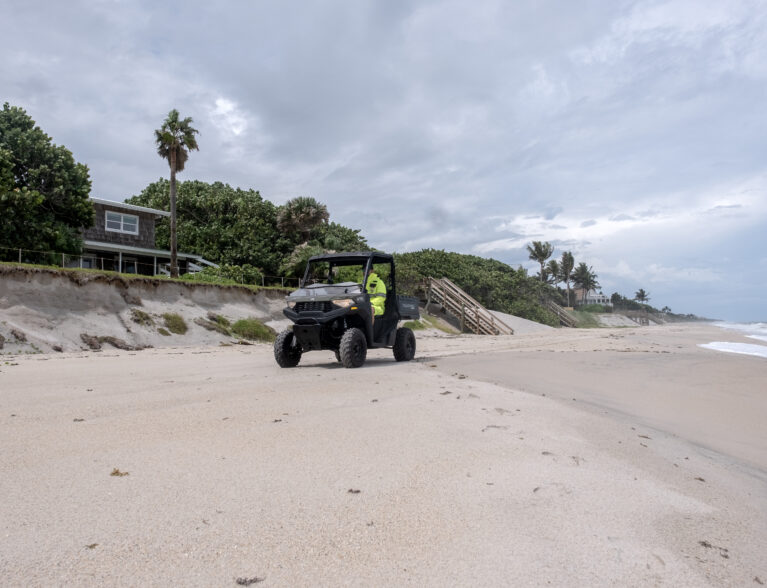
Oceanfront property owners who for years have been eager to get a much-needed infusion of sand in Indian River Shores should only have a few more weeks to wait as the county has approved a $6.6 million contract for beach replenishment from the Turtle Trail beach access south to the Tracking Station behind the 7-Eleven gas station and CVS.
Construction can begin as soon as Sea Turtle Nesting Season comes to a close at three staging areas, including some vacant land offered up by a John’s Island property owner to provide access for vehicles and equipment.
“We’re waiting for the clock to tick, so to speak, on Nov. 1,” Shores Town Manager Jim Harpring said.
Both the contractor and the sand source are located in Fort Pierce, with Dickerson Infrastructure winning the project bid, and Stewart Materials providing the mined sand that has been screened and treated to meet state environmental specifications for beach placement. Both vendors were also used for the replenishment project on the northern island beaches, with county Natural Resources Director Kylie Yanchula praising that effort for “coming in under budget and on time.”
The 2.9-mile span of beach to be shored up this fall is referred to as Sector 4 in the county’s beach plan. It had been left out of previous beach sand projects because it lacks the all-important “critically eroded” designation, despite deep escarpments near structures and feet of sand lost to storms over the past few years.
Private property owners and the John’s Island Club have spent their own money for emergency dune repairs while waiting for the county project to commence. Town taxpayers also funded the rebuilding of the Beachcomber Lane overwalk and emergency sand repairs at that beach access more than once as it became unsafe from erosion.
Shores Council Member Mary Alice Smith has worked with town staff to keep Indian River Shores beaches on the county’s priority list, as sand is one of the few investments in infrastructure that Shores residents get in return for their county property taxes.
“We know that it was like pulling teeth to get where we are on Sector 4,” Smith said. “There’s really a lot of work that went behind it.”
Town staff kept a running archive of photos showing beach conditions after every tropical storm system or Nor’easter blew through, and crews were also out documenting sand loss last week after outer bands of Hurricane Helene whipped up breezier than usual conditions on the island.
Council Member Bob Auwaerter has also worked on the long-term push to get all of Indian River Shores beaches on a regular rotation for sand replenishment, educating himself about the issue, the state regulations and how money for beach sand is doled out.
“Sector 4, is a sector of beach completely inside the Town of Indian River Shores and it constitutes most of the beach in Indian River Shores, and it’s one of the few beaches not – as we all know – not critically eroded,” Auwaerter said.
At a recent conference about resiliency, Auwaerter said he learned that in 1990, 225 miles of Florida beach was designated as “critically eroded,” but now that number is nearly 450 miles of beach.
The section of beach north of Sector 4, which would normally contribute sand to the south, is critically eroded, and has been replenished at least three times in the past 15 years.
“To me this is just more frustration which I know has been shared by the council and I know the town manager with some outside help has been trying to get this corrected,” Auwaerter said. “I’m a little bit lost as to why this is still a problem. It just shows you we’re kind of being left in the dust as compared to the other designations around the state.”
The main reason why the Shores beaches are getting sand this year is because not enough South Beach residents were willing to sign beach access easements to permit the project to proceed, and the funds could not be spent down there.
Indian River Shores residents had no problem giving the county easements to do the work, with the town even hosting a signing party to get the documents turned in quickly. Of the 88 affected parcels, the county has recorded easements for 83 of them, with 81 – or 90 percent – being required for project approval.
The county is pitching in between $676,000 and $2.3 million for the project – depending upon the availability of competitive grant funding for hurricanes Ian and Nicole restoration – with $2 million coming from the Florida Division of Emergency Management and $2.38 million from the Florida Department of Environmental Protection.
After the approximately 135,000 cubic yards of sand is placed, crews will plant more than 147,000 salt-tolerant dune plants to help hold the sand in place. All the beach construction work must be completed by April 30.



